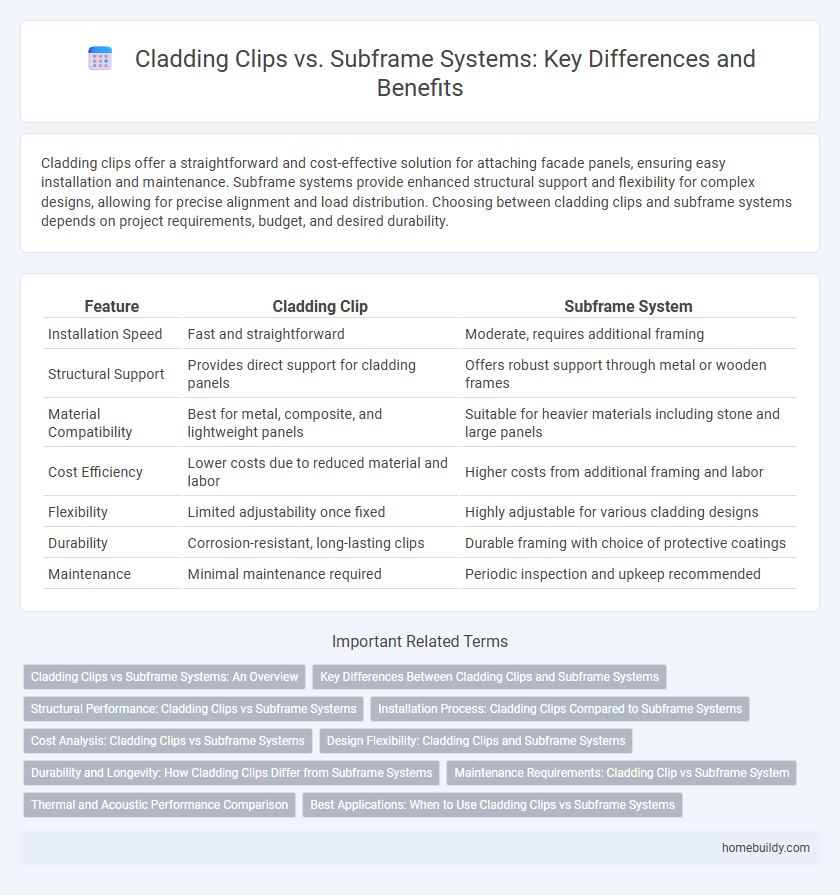Cladding clips offer a straightforward and cost-effective solution for attaching facade panels, ensuring easy installation and maintenance. Subframe systems provide enhanced structural support and flexibility for complex designs, allowing for precise alignment and load distribution. Choosing between cladding clips and subframe systems depends on project requirements, budget, and desired durability.
Table of Comparison
| Feature | Cladding Clip | Subframe System |
|---|---|---|
| Installation Speed | Fast and straightforward | Moderate, requires additional framing |
| Structural Support | Provides direct support for cladding panels | Offers robust support through metal or wooden frames |
| Material Compatibility | Best for metal, composite, and lightweight panels | Suitable for heavier materials including stone and large panels |
| Cost Efficiency | Lower costs due to reduced material and labor | Higher costs from additional framing and labor |
| Flexibility | Limited adjustability once fixed | Highly adjustable for various cladding designs |
| Durability | Corrosion-resistant, long-lasting clips | Durable framing with choice of protective coatings |
| Maintenance | Minimal maintenance required | Periodic inspection and upkeep recommended |
Cladding Clips vs Subframe Systems: An Overview
Cladding clips offer a streamlined installation process by directly attaching panels to the building facade, reducing material use compared to traditional subframe systems. Unlike subframe systems, which require extensive metal frameworks for support, cladding clips minimize structural complexity and improve ventilation behind the cladding. This results in cost savings, faster project timelines, and enhanced facade performance in terms of durability and weather resistance.
Key Differences Between Cladding Clips and Subframe Systems
Cladding clips provide a direct fastening method for exterior panels, offering a lightweight and cost-effective solution compared to subframe systems, which use metal frameworks for enhanced structural support. The subframe system allows for easier adjustment and alignment of cladding panels, improving ventilation and moisture control, while cladding clips offer faster installation with minimal material usage. In terms of durability, subframe systems are preferred for complex architectural designs and heavier cladding materials, whereas cladding clips suit simpler, lighter facades with quicker project timelines.
Structural Performance: Cladding Clips vs Subframe Systems
Cladding clips provide a direct attachment method that enhances structural stability by minimizing movement between cladding panels and the building frame, resulting in improved load distribution and resistance to wind forces. Subframe systems offer a secondary support framework that allows for greater flexibility in panel alignment and thermal expansion, but may introduce additional points of mechanical stress and require more complex installation. The choice between cladding clips and subframe systems significantly affects the overall structural performance, with cladding clips favoring rigidity and subframes supporting adaptability.
Installation Process: Cladding Clips Compared to Subframe Systems
Cladding clips offer a streamlined installation process by minimizing the need for bulky subframe components, reducing labor time and material costs compared to traditional subframe systems. These clips securely fasten cladding panels directly to the building structure, enhancing precision and ensuring consistent panel alignment. This method also facilitates easier access for maintenance and panel replacement, making it a preferred choice for efficient facade installation.
Cost Analysis: Cladding Clips vs Subframe Systems
Cladding clips significantly reduce installation costs by minimizing labor time and material expenses compared to subframe systems, which require extensive steel frameworks and additional hardware. The lightweight nature of cladding clips lowers transportation and handling costs, while subframe systems incur higher maintenance due to corrosion risks in steel components. Cost analysis reveals that cladding clips offer a more economical solution for facade attachment without compromising structural integrity.
Design Flexibility: Cladding Clips and Subframe Systems
Cladding clips offer superior design flexibility by allowing direct attachment of panels to the structure, reducing material usage and enabling intricate facade patterns. Subframe systems provide adjustable support for heavier cladding materials and accommodate larger tolerances, ideal for complex architectural designs requiring precise alignment. Both systems optimize facade stability, but clips excel in lightweight, customizable applications while subframes suit robust, large-scale installations.
Durability and Longevity: How Cladding Clips Differ from Subframe Systems
Cladding clips offer superior durability by minimizing direct contact points that are prone to corrosion, unlike traditional subframe systems that involve multiple fasteners and metal components vulnerable to rust. The flexible design of cladding clips allows for thermal expansion and contraction, reducing stress and extending the overall lifespan of the facade. Subframe systems often require more maintenance due to the complexity and exposure of their structural elements, whereas cladding clips provide a long-lasting, low-maintenance solution ideal for modern exterior cladding applications.
Maintenance Requirements: Cladding Clip vs Subframe System
Cladding clips demand less frequent maintenance due to their simplified design, which reduces the risk of corrosion and mechanical wear compared to subframe systems. Subframe systems require regular inspections to ensure the integrity of fasteners and structural components, increasing labor and material costs over time. The reduced maintenance frequency of cladding clips optimizes long-term operational efficiency in building facade installations.
Thermal and Acoustic Performance Comparison
Cladding clips offer superior thermal performance by minimizing thermal bridging compared to traditional subframe systems, enhancing building envelope insulation. They also improve acoustic insulation by reducing rigid contact points that transmit noise, resulting in better sound damping. Subframe systems, while structurally robust, often compromise on thermal and acoustic efficiency due to increased metal connectivity and potential air gaps.
Best Applications: When to Use Cladding Clips vs Subframe Systems
Cladding clips are ideal for lightweight facade installations where quick, cost-effective mounting and minimal structural interference are priorities, commonly used in renovation or retrofit projects. Subframe systems provide superior support and flexibility for heavier, larger panels or complex architectural designs, making them suitable for new construction requiring high durability and precise alignment. Selecting between cladding clips and subframe systems depends primarily on panel weight, building type, and desired installation speed.
Cladding clip vs Subframe system Infographic

 homebuildy.com
homebuildy.com